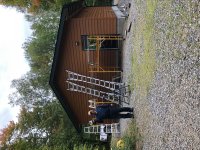check
Elite Member
- Joined
- Sep 26, 2008
- Messages
- 4,004
- Tractor
- 2009 Kubota BX25
Hello guys, here is one for you. I am installing beveled siding on the garage, and the siding supplier (Maibec of Quebec) says to join boards by cutting them at a 22 1/2 degree angle, to prevent water penetrating the joint. (As opposed to just 90 degree but joints.)
They also say to cut the 22 1/2" joints with the "visible" side facing down, and my friend who is helping me says he can't measure properly that way. The problem, of course, is that the cut at front (flat) side of the siding will be at 90 degrees, but the back (beveled) side will not. So, he is cutting the other way, but that makes the joints at the front slightly off of 90 degrees, which is I suppose acceptable, but it does look a bit funny.
View attachment Siding Joint Maibec siding.pdf

Any advice here would be much appreciated!
They also say to cut the 22 1/2" joints with the "visible" side facing down, and my friend who is helping me says he can't measure properly that way. The problem, of course, is that the cut at front (flat) side of the siding will be at 90 degrees, but the back (beveled) side will not. So, he is cutting the other way, but that makes the joints at the front slightly off of 90 degrees, which is I suppose acceptable, but it does look a bit funny.
View attachment Siding Joint Maibec siding.pdf


Any advice here would be much appreciated!

